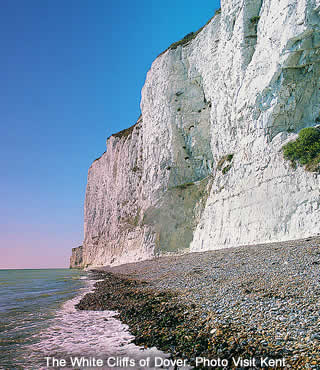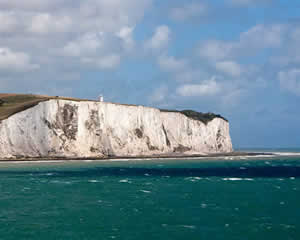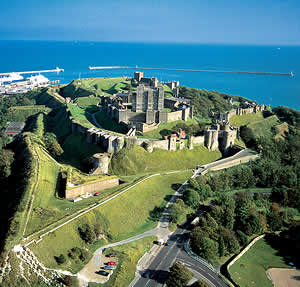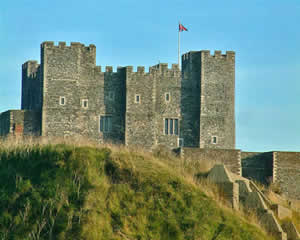Dover |
|
 |
|||
Most famous for its white chalk cliffs, which are so bright that they can be seen for miles and miles |
||||||
Listen to this article |
||||||
|
||||||
The Dover coastline is most famous for its white chalk cliffs, which are so bright that they can be seen for miles and miles. At their tallest point, they reach up to over 100 metres high. This kind of rock usually breaks in straight lines, which is why most of the cliffs are almost completely vertical. It should be noted that chunks of rock have been known to break off without warning, so make sure to keep your distance! |
||||||
Over the years, the white cliffs have become something of an icon for both the south coast, and England as a whole. This is because this part of the coastline is the closest that the British mainland gets to France. It's just 34 kilometres across, and so this stretch of water has been used as a major crossing between the two countries for hundreds, if not thousands of years. Archaeologists have found evidence of settlers from as early as the stone age. Since then, for many travellers, the White Cliffs of Dover were the first part of England that they ever saw. |
||||||
 The white cliffs of Dover Photo hans_s |
||||||
Today, the methods of transport have changed, even if the route has stayed the same. Dover's ferry port is one of the largest in the country, handling around 18 million passengers a year. The most well-known and popular route is to the French town of Calais, but there are also destinations at Belgium, and more. |
||||||
Many people move straight on from Dover as soon as they get here, but for those that stay, there's plenty to look at. The obvious starting point is Dover Castle. It looks down sternly across the water, keeping a watchful eye out for any incoming invaders. The building somewhat resembles a tree, in that there's as much of it below ground as there is above. Underneath the soil there is a vast network of tunnels, which were originally dug for use as an army barracks. They were then extended during the Second World War, and used extensively as a hospital, a communications centre, and an air-raid shelter. |
||||||
 Aerial View of Dover Castle Photo Visit Kent |
||||||
 Dover Castle Photo trevilo |
||||||
The castle also includes a Roman lighthouse, which gives some indication of the length of Dover's history. There are other remains from those days, such as a townhouse called the "Roman Painted House". Much of the plasterwork features old wall paintings, which are better preserved then in any other Roman house in England. |
||||||
Dover's history, though, goes back even further than this. Contained within Dover Museum is a boat that was used in the Bronze Age. It's 3,500 years old, which makes it the oldest boat in the world to ever sail the seas of planet Earth. |
||||||
To the west of Dover, at the town of Folkestone, the cliffs change quite significantly. The white chalk disappears, and you can see a much darker, less eye-catching rock. A pedestrian promenade follows the cliff edge; strolling along here provides the town's best sights. There are several old, impressive hotels, harking back to a time when Folkestone was one of the most popular resorts in the country. It can't claim that status now, but it can at least still offer the same great views of the French mainland. |
||||||
An even more interesting sight is at the nearby Cheriton Hill. Carved into its surface is the image of a white horse. It looks like it should have been made several thousand years ago, but in fact it was only created in 2003, as a millennium landmark. The design was based on a similar construction in Oxfordshire, which really does date from prehistoric times. The horse overlooks the northern entrance of the Channel Tunnel, which is the fastest route to France taking vehicles, trains and passengers. This famous tunnel was long in the making, being first dreamt about by a French mining engineer in 1802. Digging was even started at both ends in 1881 but abandoned over security fears. It was started again in 1974 but abandoned the following year because of costs and EU membership uncertainties. It was started for the last time in 1988 and finally opened in 1994. |
||||||
|
||||||
Dover Tourist Information Centre, Old Town Gaol, Biggin Street, Dover, CT16 1DL. Tel: 01304 205 108 |
||||||
Dover Castle (EH) is open daily, 10am to 5pm (closed Tuesdays and Wednesdays November to January). Entry costs around £16 for adults, £10 children. Castle Hill, Dover, Kent, CT16 1HU. Tel: 01304 211067 |
||||||
|
Pocket Britain is optimised for use on a smartphone or tablet with internet access. All content is subject to copyright. All reasonable methods have been used to ensure information supplied is accurate at the time of publication. However, it is advisable to check information before relying on it. Privacy Policy |